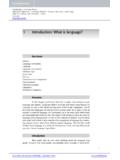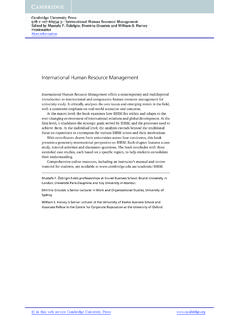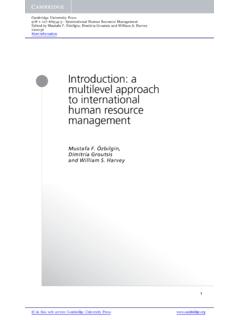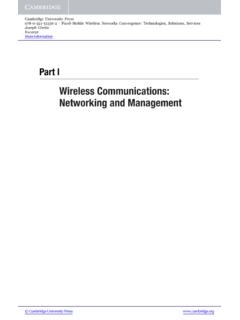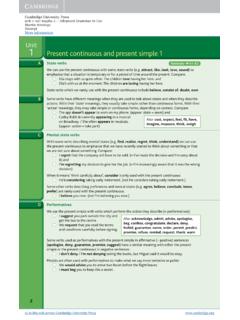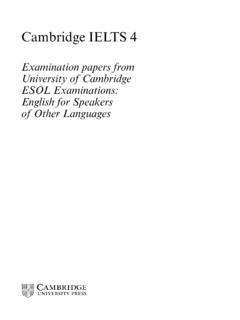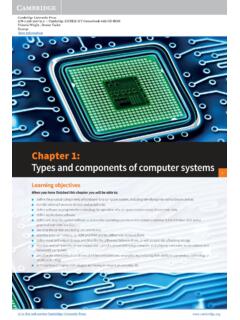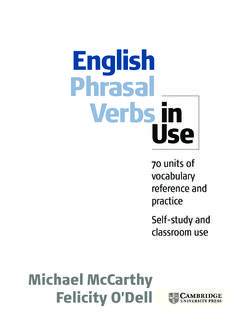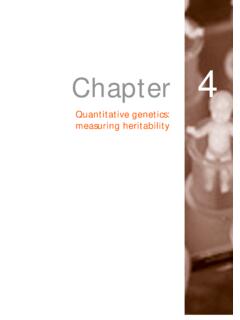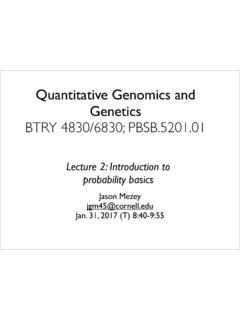Transcription of IntroductiontoConservationGenetics - Assets
1 Introduction to Conservation GeneticsThe biological diversity of the planet is being rapidly depleted due to thedirect and indirectconsequencesof humanactivity. As the size ofanimaland plant populations decreases, loss of genetic diversity reduces theirability to adaptto changes in theenvironment, with inbreedingandreduced fitness inevitable consequences for most species. This textbook pro-vides a clear and comprehensive introduction to genetic principles andpractices involved in conservation. Topics covered include: evolutionary genetics of natural populations loss of genetic diversity in small populations inbreeding and loss of fitness population fragmentation resolving taxonomic uncertainties genetic management of threatened species contributions of molecular genetics to text is presented in an easy-to-follow format, with main pointsandterms clearly highlighted. Each chapter concludes with a concise summary,which, together with worked examples and problems andanswers, illumi-nates the key principles covered.
2 Text boxescontaining interesting casestudies and otheradditional information enrich the content throughout,and over 100 beautiful pen-and-ink drawingshelp bring the material to for advanced undergraduate and graduatestudents studyingcon-servation, this book will be equally useful to practising conservation biolo-gists and wildlife managers needing an accessible introduction to thisimportant authors comprise ateam with a range of skillsand experience thatmake them uniquely qualified to put togetherthe first teaching text on con-servation genetics:dickfrankhamis Professor of Biology at Macquarie University, Sydney,Australia. He began his career in quantitative genetics, achieving interna-tional recognition for his work onDrosophilabefore turning to conservationgenetics in the early 1990s. He has made a significant contribution to theestablishment and advancement of the field and has become one of themajor figures in the Population Manager at the Smithsonian Institution sNational Zoological Park in Washington DC, USA and an adjunct member ofthe faculty at the University of Maryland.
3 His career has focused on develop-ing the science underlying the practical management of small populationsof endangered or threatened species, both captive and wild. The results ofhis studieshave been instrumental in highlighting the key roleplayed bygenetics in wildlife conservation and Associate Professor of Biology at Macquarie University,Sydney, Australia where he has been a close collaborator with DickFrankham onDrosophilaresearch, as well as working with others on rockwallabies, velvet worms and slime molds. An outstanding communicator,his inspirational teaching enthuses students at all levels and reachesbeyond the academic sphere through television appearances and popularbooks such asBiodiversity: Australia s Living Wealthto which he contributed. Cambridge University University Press0521630142 - Introduction to Conservation GeneticsRichard Frankham, Jonathan D. Ballou and David A.
4 BriscoeFrontmatterMore informationIntroduction toConservation GeneticsRichard Frankham,Macquarie University, SydneyJonathan D. BallouSmithsonian Institution, Washington,DCand David A. BriscoeMacquarie University, SydneyLine drawings byKarina H. McInnessInkbyte, Melbourne Cambridge University University Press0521630142 - Introduction to Conservation GeneticsRichard Frankham, Jonathan D. Ballou and David A. BriscoeFrontmatterMore informationpublishedbythepresssyndicateo ftheuniversityofcambridgeThe Pitt Building, Trumpington Street, Cambridge, United KingdomcambridgeuniversitypressThe Edinburgh Building, Cambridge CB2 2RU, UK40 West 20th Street, New York, NY 1011 4211, USA477 Williamstown Road, Port Melbourne, VIC 3207, AustraliaRuiz de Alarc n 13, 28014 Madrid, SpainDock House, The Waterfront, Cape Town 8001, South R. Frankham, Briscoe, Smithsonian Institution 2002 This book is in copyright.
5 Subject to statutory exceptionand to the provisions of relevant collective licensing agreements,no reproduction of any part may take place withoutthe written permission of Cambridge University published 2002 Fourth printing 2004 Printed in the United Kingdom at the University Press, SwiftSystemQuarkXPress [se]A catalogue record for this book is available from the British LibraryLibrary of Congress Cataloguing in Publication dataFrankham, Richard, 1942 Introduction to conservation genetics/Richard Frankham, Jonathan D. Ballou,and David A. Briscoe; line drawings by Karina H. bibliographical references and 0 521 63014 2 ISBN 0 521 63985 9 (pb.)1. Germplasm Briscoe, David A. (David Anthony), 1947 II. Ballou, J. D. (Jonathan D.)III. F73 34 dc212001035028 ISBN 0 521 63014 2 hardbackISBN 0 521 63985 9 paperback Cambridge University University Press0521630142 - Introduction to Conservation GeneticsRichard Frankham, Jonathan D.
6 Ballou and David A. BriscoeFrontmatterMore informationContentsPrefacexiiiCopyright acknowledgmentsxxChapter 1 Introduction1 The sixth extinction 2 Why conserve biodiversity?2 Endangered and extinct species3 What isan endangered species?6 What causes extinctions?7 Recognition of genetic factors in conservation biology9 What is conservation genetics?9 How is genetics used to minimize extinctions?11 Genetic versusdemographic and environmentalfactors inconservation biology16 What do we need to know to genetically manage threatenedspecies?16 Methodology in conservationgenetics18 Island theme19 Sources of information19 Summary19 General bibliography20 Problems21 Practical exercises :Categorizing endangerment of species22 Chapter 2 Genetics and extinction23 Genetics and the fate of endangered species24 Relationship between inbreeding and extinction27 Inbreeding and extinction in the wild29 Relationship between loss of genetic diversity and extinction36 Summary39 Further reading39 Problems40 Practical exercises :Computer projections40 SECTION IEVOLUTIONARY GENETICS OF NATURALPOPULATIONSC hapter 3 Genetic diversity45 Importance of genetic diversity46 What is genetic diversity?
7 47 Measuring genetic diversity50 Extent of genetic diversity60 Cambridge University University Press0521630142 - Introduction to Conservation GeneticsRichard Frankham, Jonathan D. Ballou and David A. BriscoeFrontmatterMore informationLow geneticdiversity inendangered species66 What genetic diversity determines evolutionary potential?67 Variation overspace and time67 What explains differences in levels of genetic diversity?68 Genetic differences among species68 Summary68 Further reading69 Problems70 Practical exercise :Measuring genetic diversity usingmicrosatellites70 Chapter 4 Characterizing genetic diversity: single loci72 Describing genetic diversity73 Frequencies of alleles and genotypes73 Hardy Weinberg equilibrium75 Expected heterozygosity78 Deviations from Hardy Weinberg equilibrium84 Extensions of the Hardy Weinberg equilibrium86 More than one locus linkage disequilibrium90 Summary93 Further reading94 Problems94 Chapter 5 Characterizing genetic diversity.
8 Quantitativevariation96 Importance of quantitative characters97 Properties of quantitative characters98 Basis of quantitative genetic variation100 Methods for detecting quantitative genetic variation103 Partitioning genetic and environmental variation105 Genotype environment interaction106 Theneed for contemporary comparisons and controlpopulations108 Partitioning of quantitative genetic variation108 Evolutionary potential and heritability111 Susceptibility to inbreeding depression120 Correlations between molecular and quantitative geneticvariation122 Organization of quantitative genetic variation122 Summary123 Further reading123 Problems124 Chapter 6 Evolution in large populations. I. Naturalselection and adaptation126 The need to evolve127 Factors controlling the evolution of populations131viCONTENTS Cambridge University University Press0521630142 - Introduction to Conservation GeneticsRichard Frankham, Jonathan D.
9 Ballou and David A. BriscoeFrontmatterMore informationSelection133 Selection on quantitative characters145 Directional selection146 Stabilizing selection149 Disruptive selection149 Summary150 Further reading150 Problems151 Practical exercises :Computer simulations152 Chapter 7 Evolution in large populations. II. Mutation,migration and their interactions with selection154 Factors controlling the evolution of populations155 Importance of mutation, migration and their interactions withselection in conservation155 Origin and regeneration of genetic diversity155 Mutation156 Selective value of mutations160 Mutation selection balance and the mutation load162 Migration167 Migration selectionequilibria and clines169 Summary173 Further reading173 Problems173 Chapter 8 Evolution in small populations175 Importance ofsmall populations in conservationbiology176 Impact of small population size :chance effects178 Inbreeding187 Measuring population size187 Selection in small populations190 Mutation in small populations191 Mutation selection equilibrium in small populations192 Computer simulation193 Summary194 Further reading194 Problems195 Practical exercises.
10 Computer simulations195 Chapter 9 Maintenance of genetic diversity197 Conservation of genetic diversity198 Fate of different classes of mutations198 Maintenance of genetic diversity in large populations199 Neutral mutations under random genetic drift200 Selection intensities vary among characters203 Balancing selection204 Maintenance of genetic diversity in small populations214 CONTENTSvii Cambridge University University Press0521630142 - Introduction to Conservation GeneticsRichard Frankham, Jonathan D. Ballou and David A. BriscoeFrontmatterMore informationSummary221 Furtherreading221 Problems222 Practical exercises :Computer simulations223 SECTION IIEFFECTS OF POPULATION SIZE REDUCTIONC hapter 10 Loss of genetic diversity in small populations227 Changes in genetic diversity over time228 Relationship between loss of genetic diversity and reducedfitness229 Effects of sustained population size restrictions on geneticdiversity231 Relationship between population size and genetic diversity inwild populations235 Effective population size239 Measuring effectivepopulation size241 Summary251 Further reading252 Problems252 Practical exercises :Computer simulations253 Chapter 11 Inbreeding254 What is inbreeding?
